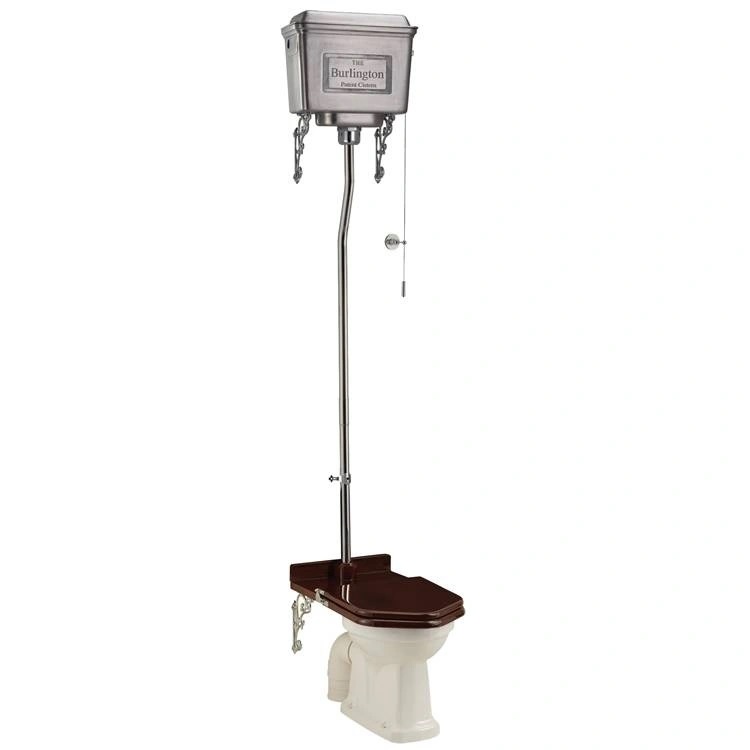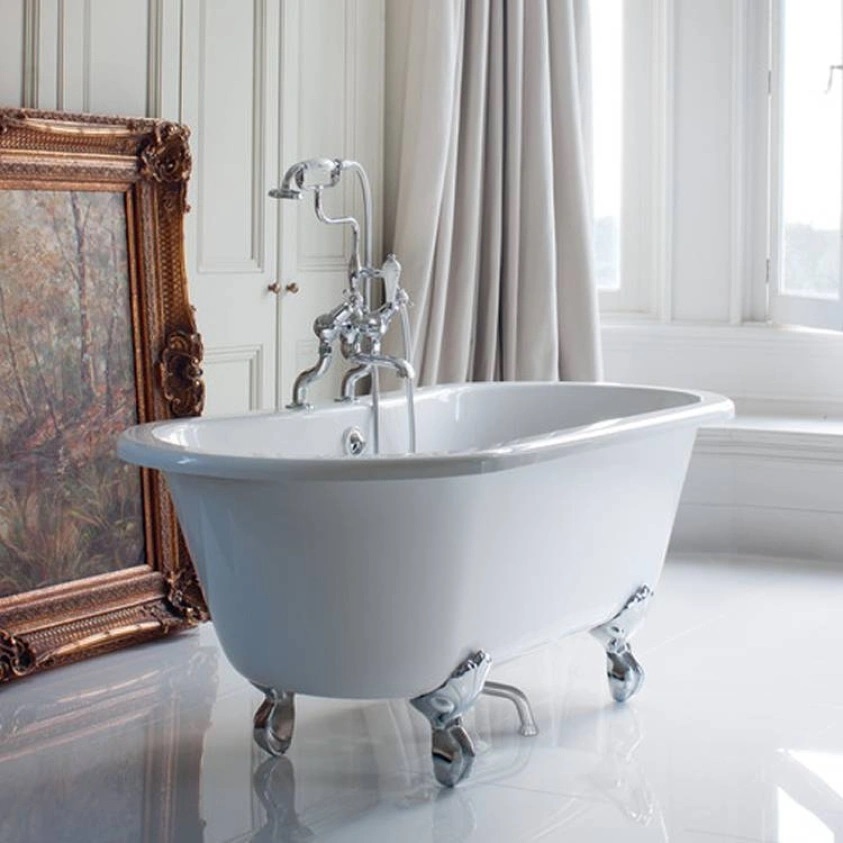Nothing compares to the clean aesthetic and effortless functionality of the modern bathroom, but if you feel like your bathroom might benefit from a bit more character, a little more colour and a few elegant touches, then perhaps the Edwardian bathroom is for you. Straddling the line between the pristine minimalism of contemporary design and the elaborate ornamentation seen in earlier eras, the Edwardian style offers an ideal blend of innovation and classical flair such that it suits our modern desire for convenience made beautiful.
In this article, we will outline every aspect of the Edwardian style, from the context of its conception, its distinction from other traditional styles, to assembling an authentic collection of features and furnishings for your own Edwardian bathroom.
When was the Edwardian Era?
While there is some dispute surrounding when the period ended, the Edwardian era began in January 1901 when King Edward VII ascended the throne of the British Empire, following the death of his mother and our then longest reigning monarch, Queen Victoria. His reign was comparatively short, passing away in May 1910. However, due to the brewing domestic and international tensions during his reign, many of which did not see resolution until the end of World War I, some historians see fit to extend the Edwardian era beyond his nine year reign to include the following decade.

Fashion in the Edwardian era was becoming more liberal. While the streets were still filled with suited men sporting bowler hats and tailored women with even more elaborate headwear, when the weather was warmer cotton clothing was swapped out for lighter linens and necklines even started to drop! The adoption of Art Nouveau from the French was especially influential on the developing domestic style in the period, while the acceleration of mass production that had started during the Industrial Revolution made the latest fashions more accessible to greater proportions of society.
What is Edwardian Style?
From their interiors to their architecture, the Edwardian style was a celebration of light and natural forms. The aforementioned Art Nouveau movement is credited with popularising the muted colour palette that we now associate with the period, as well as the influence which the curves of flowers and plants had on everything, from the design of wallpaper prints to the shape of furniture and furnishings.

While enlarged windows were paired with carefully placed of mirrors to maximise the light in each room and floral arrangements paired with statement wallpapers became increasingly common, the Edwardians had a few more sophisticated techniques for making spaces feel airer and more organic.
Wooden skirting boards ran around the floors of every room and cornices made from plaster covered the point where the walls met the ceiling, balancing the proportions of the taller Edwardian rooms while creating visual continuity across their spaces.

Moulded plaster ceiling roses even offer us an example of lightness and natural forms working in tandem, embellishing the area around light fixtures with ornate designs that were not only decorative but practical, masking the ventilation holes which removed the smoke from the gas lights.
Carpeted floors waned in popularity during the period, replaced instead with polished wooden floorboards that were covered in luxurious Persian rugs. Ceramic tiles were favoured for kitchens and bathrooms as they were deemed to be more hygienic.
What Are the Key Differences between Edwardian and Victorian Style?
Although these periods are adjacent to one another in history, it would be a mistake to assume that Edwardian and Victorian style are one and the same. As we saw in our section on British society at the start of the twentieth century, a lot can change in the span of nine years and, while there is some overlap between these traditional styles, a lot did change.
As mentioned in the previous section, floral designs are typical of the Edwardian style, which was a departure from the exotic patterns and prints that were popular during the Victorian period. The colour palettes were also vastly different in each of these eras, with the Edwardians rejecting the darker and bolder colours that saturated Victorian homes for lighter pastel shades to complement their floral statement pieces. These included yellows, greens, primrose and lilac, as well as dusky blues and pinks.
The Victorian style is often characterised by opulence and ornamentation, which is another notable difference between the periods. Ornamental displays remained a key feature in the Edwardian home, with collections of China plates and gilded picture frames adorning items of wooden furniture, however decorations tended to be sparser than in the Victorian period, while integrated storage in most furniture gave homeowners the option of concealing items at their own discretion. This similarly relates to the Edwardians’ interest in clean lines.
Did the Edwardians Have Bathrooms?
After a period of controversy in the mid-nineteenth century, starting with the recurring cholera epidemics of the early 1850s and ending with The Great Stink of 1858, the British government yielded to public pressure and accepted the proposal from Joseph Bazalgette to improve the sewerage systems under all major cities. The resulting developments made indoor plumbing accessible to most upper and middle class homes by the end of the century, while legislation passed in 1918 made access to hot and cold water mandatory for new houses. In theory, most Edwardian era houses could have facilitated a bathroom, but slow developments and some old attitudes stood in the way of this being the reality.
By the start of the Edwardian era, even the poorest households had seen fit to move their baths from in front of the fireplace to its own room. However, although the location of the bathtub had changed, bathing rituals remained the same. While laws were changing to ensure that all new working class homes would have indoor plumbing, existing homes would have to wait until the mid-twentieth century to be afforded the same luxury. This meant that many working class households continued to bathe in the way they had in the previous century, retrieving water from an outdoor pump, heating it over the stove then sharing the bathwater with all the members of the family.

https://www.pinterest.co.uk/pin/32299322297739599
Even some upper class households were resistant to change. Installing indoor plumbing in a stately home could be expensive, while labour was still relatively cheap, so for some members of the landed gentry it made more sense to continue bathing as they had done during the Victorian period. It was not until an influx of American heiresses entered the country in search of titled husbands that several stately homeowners finally acquiesced to modernisation, spurred on by complaints from their new wives.
Toilets underwent some radical updates during the Edwardian era, but it similarly took some time for the public to take advantage of these advancements. At the turn of the century, high level cisterns featuring ornamental engravings and washout closets (which relied on the water in the bowl exceeding a certain height to flush the contents along a horizontal pipeline) were still the standard. By the end of the decade, these had been replaced by toilets that were almost identical to the toilets we have today, with undecorated low level cisterns that utilised washdown and siphon jet technology.

In function and appearance, these toilets offered a cleaner option for the Edwardians, but while some homeowners started to incorporate the toilet into their bathroom, many found the idea of an indoor toilet repulsive. Even in 1920, over half of the population still had an outside toilet and it was not until the 1950s that the idea of the toilet sharing space with the bathtub became more palatable for most of the British public.
What Does an Edwardian Bathroom Look like?
In his book Homes and Gardens: Arts and Crafts Interiors published in 1923, Mackay Hugh Baillie Scott said the following with regards to bathroom design:
"In the development of the modern bathroom there [. . .] is no precedent in the tradition of the house, and in the average modern dwelling it will be well that the suggestion of spotless cleanliness and practical efficiency should be its salient characteristics."
While the ‘modern bathroom’ that Scott describes might be mistaken for any bathroom in twenty-first century, in reality the Edwardian bathroom shares many of the sensibilities that defined Edwardian interior design, while championing ‘cleanliness’ through its style as much as through its utility.
As mentioned in our section on Edwardian style, ceramic tiles were essential as much as for their hygienic as for their aesthetic quality. Seen as a practical replacement for the printed wallpapers that adorned other parts of the house, bathroom wall tiles often featured floral designs, whereas floor tiles favoured simple geometric patterns that would tessellate when installed correctly. While the walls similarly adhered to the pastel shades that brightened the rest of the Edwardian home, an earthier palette would be used on the floor, for contrast as well as to aid in cleaning.
Almost every aspect of the Edwardian bathroom somehow served to uphold the cleanliness of the space. While the pipework in the Victorian bathroom was kept on display to provide some ornamentation in their shower enclosure, exposed pipework in the Edwardian era allowed homeowners to maintain their showers, keeping them pristine and rust free. All corners of the room were open and well-lit, for fear of dirt lurking in the shadows, and any decorative furniture had integrated storage for tiding away towels or other bathroom products, just as ornaments were concealed elsewhere in the home.
What Are The Features of an Edwardian Bathroom?
As we have addressed in this article, the content of a contemporary Edwardian bathroom varied in relation to on the wealth and attitudes of its homeowner. However, when creating your own Edwardian style bathroom, feel free to indulge in any if not all the finest fixtures and furnishings the period had to offer. This final section will outline the essential features that are guaranteed to give your bathroom an authentically Edwardian feel, as well as a few optional embellishments to elevate your design and make it unique to you.
Freestanding baths featured prominently in the Edwardian bathroom, crafted from clean white enamel and showcasing the iconic roll top tub design that was first popularised during the Georgian period. For added authenticity, cast iron claw feet should adorn the bottom of the tub while brass-plated taps can be drilled or floor-mounted depending on your preference.

As stated in the previous section, the pipework of an Edwardian shower systems should be on display, often positioned vertically on the wall of the shower enclosure between the dials and the wall mounted shower head. Although shower systems from the period exclusively featured fixed position shower heads, there are systems available today which mimic the Edwardian style while also including hand showers, such that you can indulge in an anachronistic convenience without upsetting your overall aesthetic.
When it comes to the toilet, either the high level toilet or low level toilet are suited to the Edwardian style, however you should refrain from overly ornate finishes or engravings in the case of either design. Pedestal basins were usually adjacent to the toilet, their slender plinths designed to ensure both fixtures could be accommodated in even more modestly sized bathrooms. Its square shaped bowl should be embellished with stepping, creating ridges around its edge to achieve a softened silhouette. As with the freestanding bath, the basin should be paired with copper-plated taps for a truly authentic look.

Bathroom accessories should be kept to a minimum, but if you had to choose just one for your Edwardian style bathroom, it should be a bathroom mirror. Avoid anything with an ornate frame and instead favour something simple with a large surface area, such that it can catch the light and be a source for more brightness in your space.
Edwardian-Inspired Bathroom Examples
Here are some examples of some modern takes on the Edwardian bathroom, providing ideas and inspiration for how you can incorporate the style into your own home.

https://www.pinterest.co.uk/pin/6333255715516084

https://www.pinterest.co.uk/pin/577657089719477876

https://www.pinterest.co.uk/pin/82542605662404394



